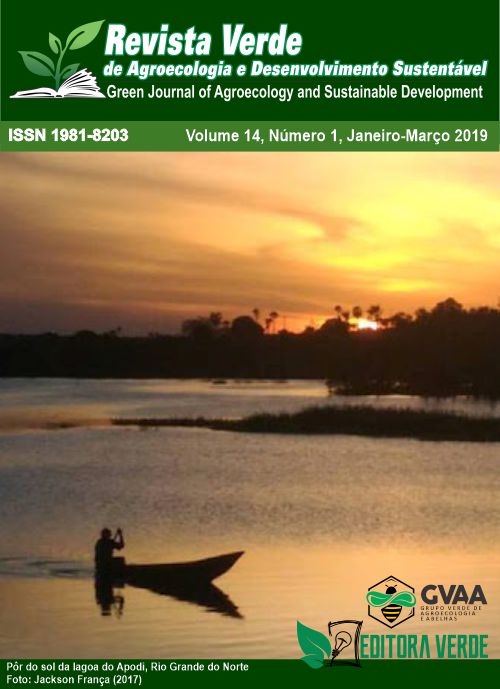Neem extract for tomato seeds treatment
DOI:
https://doi.org/10.18378/rvads.v14i1.5772Keywords:
Azadirachta indica, Solanum lycopersicum L., Physiology, SanityAbstract
Organic production systems should be implanted using organic seeds free of microorganisms and without chemicals application. Neem extracts has been shown to be efficient to control seed microorganism, however its effects on the physiological seed quality, is still unknown. The aim of this work was to identify the viability of aqueous extract of neem leaf as an alternative to the chemical treatment in tomato seeds Super Marmande cultivar. The experiment was carried out in a laboratory of the State University of Piauí campus Corrente. Different concentrations of neem aqueous extract were prepared using 0, 40, 80, 120, 160 and 200 grams of neem leaves per 1 liter of distilled water. Doses of each concentration containing 8 ml of the aqueous extract were used to treat 100 tomato seeds. A dose of thiran (3 grams per kilogram of seed) was used as chemical control. After the treatment, seeds were evaluated for germination, first counting of germination, cold, field seed emergence, emergence speed index, dry matter of seedlings and frequency index of contaminants. For this study a completely randomized design was emplyed, with 7 treatments and 4 replicates. None of the neem aqueous extracts concentrations altered physiological quality of tomato seeds. Moreover, the neem extracts with a concentration of 160 and 200 g L-1 were efficient to reduce contaminants present in the seeds. Based on our results, the application of neem extracts could be an efficient alternative for organic treatment of tomato seeds replacing chemical treatments.Downloads
References
ALMEIDA, T. F.; CAMARGO, M.; PANIZZI. R. C. Efeito de extratos de plantas medicinais no controle de Colletotrichum acutatum, agente causal da flor preta do morangueiro. Summa Phytopathol., v.35, n.3, p.196-201, 2009.
AMADIOHA, A. C. Controlling rice blast in vitro and in vivo with extracts Azadirachta indica. Crop Protection, v.19, n.5, p.287-290, 2000. 10.1016/S0261-2194(99)00080-0
AMADIOHA, A. C.; UCHENDU, P. N. Post harvest control of tomato fruit rot caused by Fusarium solani with extracts of Azadirachta indica. African Journals online, v.15, n.1, 2003. 10.4314/dai.vl5il.15629
ARAÚJO, E. R.; HARAND, W.; LIMA, I. C; DIAS, F. C. R.; SANTANA, A. A. D.; CARVALHO, R. R.C.; LARANJEIRA, D. Extratos de Piper marginatum e Azadirachta indica no controle de Colletotrichum scovillei em pimentão. Pesquisa agropecuária brasileira, v.49, n.2, p.88-94, 2014.
BHONDE, S. B.; DESHPANDE, S. G.; SHARMA, R. N. In vitro evaluation on inhibitory nature of some Neem formulations against plant pathogenic fungi. Hindustan Antibiot., v.41, p.22-24, 1999.
BRASIL. Ministério da Agricultura, Pecuária e Abastecimento. Instrução Normativa nº17, de 18 de junho de 2014. Altera artigos da IN 46. Diário Oficial da União; Poder Executivo, 2014.
BRASIL. Ministério da Agricultura, Pecuária e Abastecimento. Instrução Normativa nº64, de 19 de dezembro de 2008. Aprovar o Regulamento Técnico para os Sistemas Orgânicos de Produção Animal e Vegetal. Diário Oficial da União; Poder Executivo, 2008.
BRASIL. Manual de Análise Sanitária de Sementes. Brasília: MAPA/ACS, 2009a. 200p.
BRASIL. Regras para análise de sementes. Brasília: MAPA/ACS. 2009b. 399p.
CHATTOPADHYAY, C. Yield loss attributable to alternaria bligh of sunflower (Helianthus annuus L.) in India and some potentially effective control measures. International Journal of Pest Management, v.45, n.1, p.15-21, 1999. 10.1080/096708799227996
FERREIRA, D. F. Sisvar: a computer statistical analysis system. Ciência e agrotecnologia, v.35, n.6, p.1039-1042, 2011.
GONÇALVES, A. P. P.; VIEIRA, G. D.; CUNHA, P. N. A.; KISSLER, T. V. L.; HERNÁNDEZ, A. E. F.; TELES, C. B. G. Caracterização fitoquímica e atividade antimicrobiana de extratos de Solanum subinerme (Solanaceae). Revista Brasileira Pesquisa Saúde, v.18, n.2, p.8-16, 2016.
LOPES, C. A. Hortaliças orgânicas só podem ser produzidas com sementes orgânicas?, 2014. Disponível em: <http://www.embrapa.br/busca-de-noticias/-/noticia/3234227/hortalicas-organicas-so-podem-ser-produzidas-com-sementes-organicas>. Acesso em: 14 set. 2016.
MAGUIRE, J. D. Apeed of germination-aid in selection and evalution for seedling emergence and vigor. Crop Science, v.2, n.2, p.176-177, 1962.
MAIRESSE, L. A. S.; COSTA, E. C.; FARIAS, J. R.; FIORIN, R. A. Bioatividade de extratos vegetais sobre alface (Lactuca sativa L.). Revista da FZVA, v.14, n.2, p. 1-12. 2007.
MALAVOLTA, V. M. A.; SOLIGO, E. A.; DIAS, D. D.; AZZINI, L. E.; BASTOS, C. R. Incidência de fungos e quantificação de danos em sementes de genótipos de arroz. Summa Phytopathol., v.33, n.3, p.280-286, 2007.
MELO, P. C. T.; MELO, A. M. T.; NASCIMENTO, M. M.; FREITAS, R. A. Produção de sementes de tomate. In: NASCIMENTO, W.M. (ed.). Produção de sementes de hortaliças. v2. Brasília: Embrapa, 2014. p.235-263.
NEVES, B. P.; OLIVEIRA, I. P.; NOGUEIRA, J. C. M. Cultivo e utilização do nim indiano. Embrapa Arroz e Feijão-Circular Técnica 62 (INFOTECA-E), 2003.
OWOLADE, O. F.; AMUSA, A. N. ; OSIKANLU, Y. O. K. Efficacy of certain indigenous plant extracts against seed-borne infection of Fusarium moniliforme on maize (Zea mays L.) in south western Nigeria. Cer.Res. Commun, v.28, p.323-32, 2000.
PESKE, S. T.; VILLELA, F. A.; MENEGHELLO, G. E. Sementes: fundamentos científicos e tecnológicos. Pelotas: Editora Universitária UFPel, 2012. 573p.
RICKLI, H. C.; FORTES, A. M. T.; SILVA, P. S. S.; PILATTI, D. M.; HUTT, D. R. Efeito alelopático de extrato aquoso de folhas de Azadirachta indica A. Juss. em alface, soja, milho, feijão e picão-preto. Semina, v.32, n.2, p.473-484, 2011.
ROSSETTO, C. A. V.; LIMA, T. M.; NAKAGAWA, J. Avaliação da aplicação de fungicida e do condicionamento osmótico durante o armazenamento de sementes de tomate. Revista Brasileira de Sementes, v.23, n.2, p.229-235, 2001.
SILVA, J. P.; CROTTI, A. E. M.; CUNHA, W. Antifeedant and allelopathic activities of the hydroalcoholic extract obtained from Neem (Azadirachta indica) leaves. Brazilian Journal of Pharmacognosy, v.17, n.4, p.529-532, 2007. 10.1590/S0102-695X2007000400009















